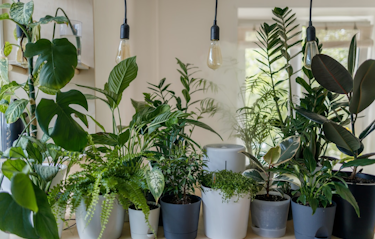
The Best Indoor Plants For Clean Air
- Easy Care
- Asparagacea
- Large
- Evergreen Perennial
We independently select everything we recommend. When you buy through our links, we may earn a commission.
Ponytail palms are a popular houseplant, but they’re not actually palm trees at all. This cute plant gets its name from its resemblance to a girl’s ponytail, and they are very easy to grow for most anyone, with the caveat not to overwater them.
Published on 19 August, 2023 by Oliver Rouane-Williams



Elephant’s Foot Tree Bottle Palm Pony Tail Plant
The ponytail plant is a cute, low-maintenance tropical plant that most people have success growing. An air purifier that adds greenery to your living space, they have a very distinct look to them. A ponytail palm has a fairly thick and stumpy bulbous trunk at the base of the plant that tapers toward the top into a much thinner stem.
This plant is relatively slow-growing when grown inside and can live for decades if given the right growing environment.
Ponytail Palm (Beaucarnea recurvata) in the Asparagaceae family.
Despite its name, the ponytail palm is not a true palm tree (Arecaceae family).
The ponytail palm is an evergreen perennial, which means it is a small shrub or tree that holds its green leaves year-round.
This plant grows natively in Belize, Guatemala, and parts of Mexico.
The ponytail palm plant has a distinct look. The base of the trunk is quite large, almost bulbous, while the top of the trunk tapers before giving way to a crown of long slender leaves. The dark green, curling leaves come out in tufts, resembling a woman’s ponytail.

Gold Star Ponytail Palm (Beaucarnea Variegated)
Mexican Ponytail Palm (Beaucarnea Gracilis)
Beaucarnea Compacta
Styling ponytail palms depends on how big you want them to grow and where you want to display them. Ponytail palms can be grown in small, flat pots and pruned into a bonsai tree. If you have one of the larger varieties, you can slowly repot them into larger pots every few years to encourage larger growth.
At 2-4 feet tall, these beauties make excellent focal points in corners, windows, and entryways.

The ponytail palm does best in full sun or direct sun. They can also do well in a bright room without direct sunlight, but they’ll grow more slowly. Just be sure to place this plant in the brightest room in your house.
You must be careful about not over-watering ponytail palms. Part of their low-maintenance appeal is that they can go a long time between waterings. The top 2-3 inches of soil must dry out completely between waterings. Over-watering them can lead to root rot and yellowing leaves.
These plants thrive in temperatures from 60-80 degrees Fahrenheit.
A ponytail palm plant prefers dry conditions and low humidity.
This plant prefers well-draining soil. Plant your ponytail palm in a cactus or succulent potting mix. If you don’t have that on hand, you can mix 1/3 potting soil, 1/2 perlite and 1/3 sand.
Ponytail palm houseplants generally do not require pruning as they are a very slow grower. Always prune brown or dead leaves with clean, sharp scissors. For small varieties, you can prune the leaves to alter the shape of the plant.
A ponytail palm plant should be fertilized once per year, in the spring, with a 10-10-10 slow-release fertilizer mix. A 10-10-10 fertilizer contains 10 percent nitrogen, 10 percent phosphate and 10 percent potash.
Although they can get quite large when grown in the wild, indoor ponytail palm trees rarely get taller than four feet tall. Most top out around two feet.
Ponytail palms are safe and non-toxic.
These plants are non-toxic to pets. However, the springy, curling leaves may be a tempting toy for kitty!
Spider Mites: If your plant gets spider mites, cover the pot with a sealable plastic bag and put it in the shower. Blast the leaves with high-pressure water to dislodge the pests. Don’t worry, the ponytail palm leaves are built to withstand tropical storms in the wild!
Mealybugs: These pests can damage your plant, but you can get rid of them using a cotton swab and isopropyl alcohol.
Over-watering: The first sign of over-watering is yellowing leaves.
Brown Leaves: Believe it or not, this can be a sign of both over- and under-watering. Remember the tip of checking the soil by sticking your finger down into it.
The ponytail palm plant or tree develops “pups” or side shoots as the plant matures. These are tiny versions of the bigger plant, and if you remove the pups correctly, you can share your lovely plant with others.
Spring is the perfect time to remove the pups. Start by pulling the dirt away from the base of the plant. Using a clean knife, you can remove the pup from the trunk. Pups that are at least four inches in length make the best starters.
After dipping the pup end in rooting hormone, you are ready to plant it. Remember the type of soil these plants prefer, and once planted, cover the container with a plastic bag. The bag can be removed every few days to mist the pup. Once the roots are established, and you see new growth, you can care for the plant as usual.

Ponytail palms need sun and prefer bright light. They can do well in bright, indirect light also.
A ponytail palm needs water once every two weeks or so. Determine moisture by sticking your finger into the soil. If the soil is dry 2-3 inches deep, it may be time to water.
Although these plants get quite big in their natural habitat, they rarely grow taller than 2-4 feet when potted properly and kept indoors. You can also grow smaller varieties as a bonsai tree.

Delivered to your inbox every Saturday morning
